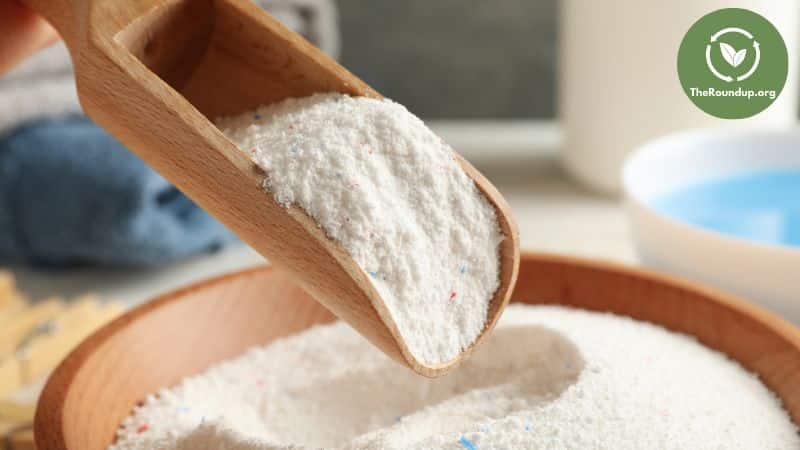Want a greener, cheaper way to do laundry? DIY laundry detergent could be the answer you're looking for!
Commercial detergents often contain harmful chemicals and come in wasteful plastic packaging. Eco-friendly laundry detergent brands offer convenience and sustainability but can be expensive.
By making your own, you control the ingredients, reduce waste, and save money. Plus, after months of testing, I've seen that homemade detergents work as well as shop-bought options.
This guide will show you how to make detergent quickly and easily. Let's dive into a cleaner, greener laundry routine and save a few bucks!
Why Make DIY Laundry Detergent?

Cost-effective
By purchasing essential ingredients like washing soda, baking soda, and Castile soap in bulk, you can reduce the cost per load to just a few cents.
Health Benefits
By making your own detergent, you have complete control over the ingredients.
This means you can avoid adding many of the typical nasties lurking in conventional detergents, such as:
- Synthetic Fragrances: Synthetic fragrances contain petrochemicals that release volatile organic compounds (VOCs).
- Bleach (Chlorine): Chlorine bleach can irritate the skin, eyes, and the respiratory system.
- Dyes: Many commercial detergents contain synthetic dyes. These dyes do not help with cleaning and can cause allergic reactions and skin irritation.
- Preservatives and Stabilizers: Commercial detergents often contain preservatives. They can cause skin irritation and other health issues.
- Sulfates: Sulfates such as sodium lauryl sulfate (SLS) can be harsh on the skin and cause skin irritation.
Environmental Benefits
- No Phosphates: Phosphates improve detergent cleaning efficiency but cause environmental harm. They lead to eutrophication, which promotes excessive algae growth in water bodies. This depletes oxygen, harming aquatic life.
- Reduce Plastic Waste: By storing DIY detergent in reusable containers, you reduce plastic waste.
- Biodegradability: Many ingredients in homemade detergents are biodegradable.
- Lower Carbon Footprint: Making detergent at home reduces carbon emissions. You avoid the production, packaging, and transportation processes of commercial detergents. This helps cut down on pollution and energy use.
How Do You Make Homemade Laundry Detergent Powder?
Ingredients Overview
- 1 Cup Sodium Bicarbonate (Baking Soda): Helps to neutralize odors, soften water, and boost cleaning power. I like you use an aluminum-free baking soda to avoid unnecessary additives.
- 1 Cup Sodium Carbonate (Washing Soda): A powerful cleaner and water softener that helps to remove grease, oil, and stains from clothes. It also enhances the effectiveness of detergent by making the water more alkaline.
- 1 Cup Borax: A naturally occurring mineral that helps to whiten clothes, remove stains, and enhance overall cleaning power. Borax is also effective at controlling odors and softening water.
- 1 Bar Castile Soap: A gentle yet effective soap made from vegetable oils. It's biodegradable, non-toxic, and safe for sensitive skin.
- 20 Drops Essential Oils (Optional): Adds a pleasant scent to your detergent. I love the combination of lemon and lavender (refreshing and calming). I always choose high-quality, pure oils to avoid synthetic additives.
Recipe Instructions
- Grate the Soap: Grate the Castile soap into fine flakes using a cheese grater. Or buy Castile soap flakes to remove this step.
- Mix Ingredients: Combine the grated soap, washing soda, baking soda, and borax in a large bowl.
- Add Essential Oil (Optional): Add 20 drops of your chosen essential oil(s) to the mixture.
- Blend for Finer Texture (Optional): I like to use a food processor to blend the mixture for a finer powder. This means the powder will dissolve more quickly in the wash.
Recipe Tweaks
After much testing, the recipe above consistently produced the best results for me.
However, I understand that one size doesn't fit all, so here are a few tweaks you might like to make depending on your individual needs:
- Borax-Free Powder (Swap Borax for 1 Cup Citric Acid): Citric acid is a natural cleaner. It helps soften water, remove stains, and break down mineral deposits. This makes it a great alternative to borax. Using citric acid ensures the detergent is safe for those with sensitivities to borax. Plus, it still provides effective cleaning power.
- Sensitive Skin Powder (Swap Borax for 1 Cup Epsom Salt): Epsom salt is gentle on the skin and can help to soften fabrics. It also reduces skin irritation, making this recipe ideal if you have sensitive skin or allergies.
- High-Efficiency (HE) Washer Safe Powder (Add 1/4 Cup Kosher Salt): Kosher salt helps to prevent suds, making this detergent suitable for HE washers that require low-sudsing formulas.
Storage Instructions
- Choose the Right Container: Store your DIY laundry powder in an airtight container. I prefer to use glass jars with tight-sealing lids (large mason jars are excellent choices). Alternatively, you can reuse old plastic containers with secure lids. But make sure they're BPA-free to avoid chemical leaching.
- Label Clearly: Label the container with its contents and date of preparation. This will help you keep track of its age and ensure everyone in the household knows what it is.
- Store in a Cool, Dry Place: Keep the container in a cool, dry place, away from moisture and direct sunlight. Excess moisture can cause the powder to clump and lose its effectiveness. I like to add silica packets or a cheesecloth with rice inside to help absorb excess moisture.
- Avoid Contamination: Use a clean, dry scoop to measure out the detergent each time you do laundry. Do not use wet hands or utensils.
Usage Instructions
- Measure the Detergent: For a standard load of laundry, I use 1-2 tablespoons of DIY laundry powder. Adjust the amount based on the size of the load and the level of soiling.
- Add to Washer: Add the measured detergent directly into the washing machine drum before adding clothes. This allows the detergent to dissolve properly and mix evenly with the water. If you have a high-efficiency (HE) washer, place the detergent in the designated detergent dispenser.
- Select Water Temperature: For best results, I use warm water for heavily soiled loads and cold water for regular or lightly soiled loads. This helps to dissolve the detergent more effectively and enhances its cleaning power.
- Boost Cleaning Power: For extra cleaning power, I add 1/2 cup of white vinegar to the rinse cycle. This helps to remove any remaining detergent residue and acts as a natural fabric softener.
- Stain Treatment: I often pre-treat stubborn stains by making a paste of laundry powder and a little water. I apply the paste to the stain, let it sit for 10-15 minutes, and then wash as usual.
- Drying: I like to use a sustainable drying method once my clothes are clean. My preferred options (depending on the weather) are eco-friendly dryer sheets, air drying on an outside line, and wool dryer balls.
How Do You Make DIY Liquid Laundry Detergent?
I prefer DIY laundry powder. It's quicker to make, easier to store and does an excellent job cleaning my clothes.
However, here's how you can tweak the recipe if you prefer liquid detergent.
Tweaked Recipe
- Grate the Soap: Use a cheese grater to grate the bar of Castile soap into fine flakes.
- Melt the Soap: In a large pot, heat 4 cups of water until almost boiling. Add the grated soap and stir continuously until it's completely melted.
- Combine Ingredients: Add the melted soap mixture, 1 cup of washing soda, 1 cup of baking soda, and 1 cup of borax to a 5-gallon bucket. Stir the mixture until all the powders are fully dissolved.
- Add Water: Fill the bucket halfway with hot water and stir well. Then, add cold water to fill the bucket, stirring continuously to ensure everything is mixed.
- Add Essential Oils (Optional): If you're using essential oils, add them now and stir well to distribute the fragrance evenly.
- Let It Sit: Cover the bucket and let the detergent sit overnight to thicken. This will allow the mixture to gel and ensure all ingredients are thoroughly mixed.
- Storage: Transfer the liquid detergent to clean, reusable containers for easy use. I find old detergent bottles or large glass jars work best. Don't forget to label each container clearly.
Frequently Asked Questions
What is Fels-Naptha?
Fels-Naptha is a bar soap used to treat stains. It effectively removes grease and dirt from fabrics and appears in many DIY laundry soap recipes. However, I prefer the Castile soap's performance.
Is homemade laundry soap safe for septic systems?
Yes, homemade laundry soap is generally safe for septic systems because it contains biodegradable ingredients like Castile soap, washing soda, and baking soda.
Is homemade laundry soap effective in cold water washes?
Yes, homemade laundry soap is effective in cold water washes if you finely grate the soap. I find that dissolving the detergent in warm water before adding it to a cold wash helps.
Does DIY liquid laundry soap make suds and bubbles?
No, DIY liquid laundry soap usually doesn't make a lot of suds and bubbles. This is normal and does not affect its cleaning effectiveness.
How do I prevent soap residue from building up in my washing machine?
Use the right amount of detergent to prevent soap residue from building up in your washing machine. I run an empty hot water cycle with 1 cup of white vinegar monthly to clean the drum and hoses. I also wipe down the drum, door, and gasket with a damp cloth after each use to remove any remaining soap and lint.
The Final Word
Using simple natural ingredients like washing soda, baking soda, and Castile soap bars gives you complete control over your laundry detergent's ingredients. It helps keep toxins out of your clothes and the environment.
This guide offers easy-to-follow recipes for natural laundry detergent, both powder and liquid. It includes practical tips for storage and usage. Whether you have sensitive skin, need a borax-free option, or use a high-efficiency washer, there’s a tweak for you.
Don't feel confident enough to make homemade laundry detergent? Check out my favorite eco-friendly laundry detergent brands for a fantastic combination of convenience and washing power.



